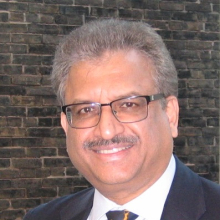Bantwal R. (Rabi) Baliga
Professor (Post-Retirement)

Ph.D. University of Minnesota
M.Sc. Case Western Reserve University
B.Tech. Indian Institute of Technology, Kanpur
MECH 220: Mechanics 2 (3 Credits)
MECH 240: Thermodynamics 1 (3 Credits)
MECH 341: Thermodynamics 2 (3 Credits)
MECH 346: Heat Transfer (3 Credits)
MECH 565: Fluid Flow & Heat Transfer Equipment (3 Credits)
MECH 650: Fundamentals of Heat Transfer (4 Credits)
MECH 654: Computational Fluid Flow and Heat Transfer (4 Credits)
- Atabaki, N., Jesuthasan, N., and Baliga, B.R. (2022), Hybrid numerical models for predictions of thermofluid phenomena in engineering systems, with application to a loop heat pipe in steady operation, Advances in Heat Transfer, Vol. 54, pp. 179-239.
- Venne, K., Torriano, F., Mydlarski, L., and Baliga, B. R. (2022), Validation of a numerical model for hot-spot detection on the surface of a rotor pole using a scale model of a hydroelectric generator, Applied Thermal Engineering, Vol. 215, pp. 118967-1-13.
- Medvescek, J.I., Mydlarski, L., and Baliga, B.R. (2021), Densities of dilute aqueous solutions of 1-Butanol and 1-Pentanol at atmospheric pressure and temperatures in the range of 283.15 to 353.15 K, Journal of Chemical & Engineering Data, Vol. 66, pp. 1582-1591.
- Hewes, A., Medvescek, J.I., Mydlarski, L., and Baliga B.R. (2020), Drift compensation in thermal anemometry. Measurement Science and Technology, Vol. 31, pp. 045302-1-11.
- Lamoureux, A. and Baliga, B.R. (2020), Numerical predictions of temporally periodic fluid flow and heat transfer in spatially periodic geometries, in Runchal, A.K. (Editor), 50 Years of CFD in Engineering Sciences - A Commemorative Volume in Memory of D. Brian Spalding, pp. 185-230, Springer Nature Singapore Pte Ltd.
- Cimmino, M. and Baliga, B.R. (2019), A hybrid numerical-semi-analytical method for computer simulations of groundwater flow and heat transfer in geothermal borehole fields, International Journal of Thermal Sciences, Vol. 142, pp. 366-378.
- Lokhmanets, I. and Baliga, B.R. (2019), Experimental investigation of steady and transient operations of a single-phase closed-loop vertical thermosyphon, International Journal of Thermal Sciences, Vol. 145, pp. 105988-1-14.
- Gubian, P.A., Stoker, J., Medvescek, J.I., Mydlarski, L., and Baliga, B.R. (2019), Evolution of wall-shear stress with Reynolds number in fully developed turbulent channel flow experiments, Physical Review Fluids, Vol. 4, pp. 074606-1-15.
- Cimmino, M. and Baliga, B.R. (2017), Evaluation of the interfacial conduction heat transfer coefficient in two-temperature macroscopic models of homogeneous porous media using a fully developed unsteady microscopic model in periodic unit cells. Numerical Heat Transfer - Part B: Fundamentals, Vol. 71, pp. 236-252.
- Baliga, B.R. and Lokhmanets, I. (2016). Generalized Richardson extrapolation procedures for estimating grid- independent numerical solutions, International Journal of Numerical Methods for Heat & Fluid Flow, Vol. 26, pp. 1121-1144.
- Lamoureux, A. and Baliga, B.R. (2015), Hybrid numerical methods combining discretized multidimensional and segmented-quasi-one-dimensional models for simulating thermofluid systems, International Journal of Numerical Methods for Heat & Fluid Flow, Vol. 25, pp. 1404-1425.
- Scott, D. A., Lamoureux, A., and Baliga, B. R. (2013), Modeling and simulations of laminar mixed convection in a vertical pipe conveying slurries of a microencapsulated phase-change material in distilled water, ASME Journal of Heat Transfer, Vol. 135, pp. 011013-1-13.
- Kattoura, S., Lamoureux, A., and Baliga, B. R. (2013), A control-volume finite element method for the prediction of three-dimensional diffusion-type phenomena in anisotropic media, Computational Thermal Sciences, Vol. 5, pp. 249-260.
- Lamoureux, A. and Baliga, B. R. (2011), Improved formulations of the discretized pressure equation and boundary treatments in co-located equal-order control-volume finite-element methods for incompressible fluid flow, Numerical Heat Transfer, Part B: Fundamentals, Vol. 59, pp. 442-472.
- Duplain, E. and Baliga. B.R., 2009. Computational optimization of the thermal performance of internally finned ducts, International Journal of Heat and Mass Transfer, Vol. 52, pp. 3929-3942, 2009.
- Jesuthasan, N. and Baliga, B.R. (2009), A numerical method for three-dimensional parabolic flow and heat transfer in straight ducts of irregular cross-section, Computational Thermal Sciences, Vol. 1, pp. 259-288.
- Costa, V.A.F., Oliveira, L.A., and Baliga, B.R. (2008), Implementation of the stress jump condition in a control-volume finite-element method for the simulation of laminar coupled flows in adjacent open and porous domains, Numerical Heat Transfer, Part B: Fundamentals, Vol. 53, pp. 383-411.
- Atabaki, N. and Baliga, B.R., 2007. Effective thermal conductivity of water-saturated sintered powder-metal plates, Heat and Mass Transfer, Vol. 44, pp. 85-99.
- Acharya, S., Baliga, B.R., Karki, K., Murthy, J.Y., Prakash, C., and Vanka, S.P. (2007), Pressure-based finite volume methods in computational fluid dynamics, ASME Journal of Heat Transfer, Vol. 129, pp. 407-424.
- Baliga, B. R. and Atabaki, N. (2006), Control‐volume‐based finite‐difference and finite‐element methods, in W. J. Minkowycz, E. M. Sparrow, and J. Y. Murthy (Editors), Handbook of Numerical Heat Transfer, 2nd Ed., John Wiley, New York, Chap. 6, pp. 191-224.
- Passive capillary-driven high-heat-flux devices (loop heat pipes, heat pipes, micro-groove vapor-chamber spreaders)
- Closed-loop thermosyphons
- Heat transfer in slurries of microencapsulated phase-change materials
- Thermal energy storage in rock beds and solid-liquid phase-change systems
- Compact and ultra-compact heat exchangers
- Prediction and mitigation of spotting phenomena in forest fires
- Control-volume finite element methods for fluid flow and heat transfer
- Hybrid Multi-Dimensional-Quasi-One-Dimensional Numerical Models
Primary Research Theme: Combustion and Energy Systems
Secondary Research Theme: Aerodynamics and Fluid Mechanics
Current research activities mainly involve numerical and experimental investigations of fluid flow and heat transfer, with applications to the design and optimization of energy exchange, storage, and conversion systems. Particular applications include passive capillary-driven high-heat-flux devices (loop heat pipes, heat pipes, micro-groove vapor-chamber spreaders), closed-loop thermosyphons, compact and ultra-compact heat exchangers, thermal energy storage in rock beds and solid-liquid phase-change systems, heat transfer in slurries of suspended microencapsulated solid-liquid phase-change materials in liquids, predictions and mitigation of spotting phenomena in forest fires, gas-solid-particle flows with and without combustion, geothermal heat pumps, and internally finned ducts.
Please note that currently I am not recruiting any new graduate students.